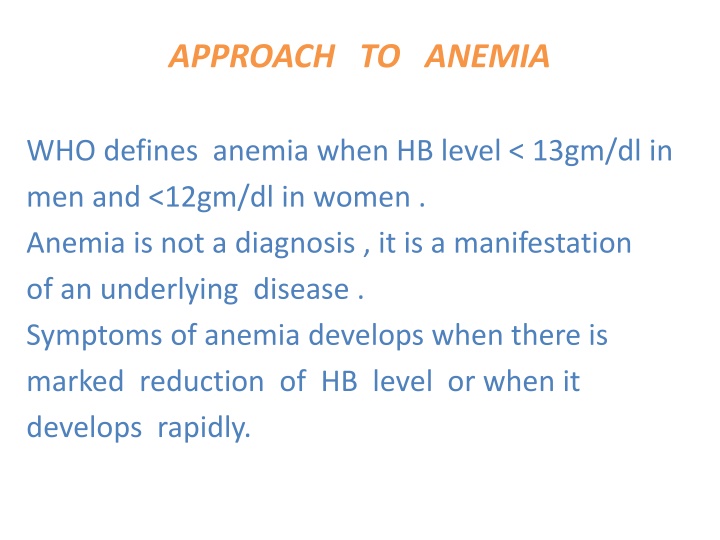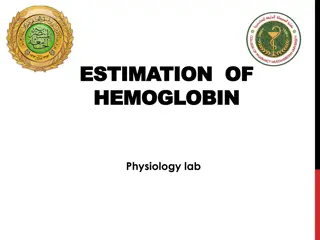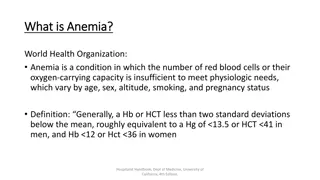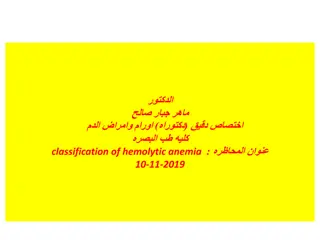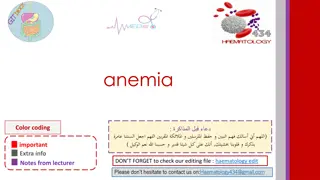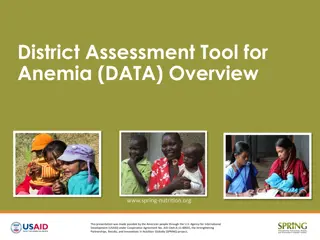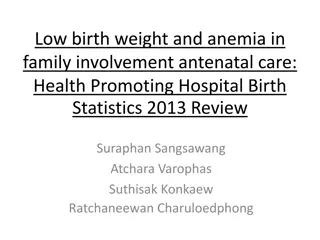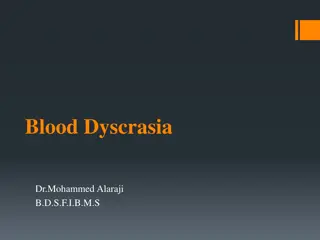Approach to Anemia Evaluation & Management
Anemia is not a standalone diagnosis but a sign of an underlying condition. Learn about diagnostic approaches, evaluation through history, physical examination, and investigations, along with symptoms and classification of anemia.
Download Presentation

Please find below an Image/Link to download the presentation.
The content on the website is provided AS IS for your information and personal use only. It may not be sold, licensed, or shared on other websites without obtaining consent from the author.If you encounter any issues during the download, it is possible that the publisher has removed the file from their server.
You are allowed to download the files provided on this website for personal or commercial use, subject to the condition that they are used lawfully. All files are the property of their respective owners.
The content on the website is provided AS IS for your information and personal use only. It may not be sold, licensed, or shared on other websites without obtaining consent from the author.
E N D
Presentation Transcript
APPROACH TO ANEMIA WHO defines anemia when HB level < 13gm/dl in men and <12gm/dl in women . Anemia is not a diagnosis , it is a manifestation of an underlying disease . Symptoms of anemia develops when there is marked reduction of HB level or when it develops rapidly.
Diagnostic Approaches To Anemia 1- Is the patient anemic ? 2- How severe is the anemia ? 3- What type of anemia ? 4- Why the patient is anemic ? 5- What should be done ?
EVALUATION OF ANEMIA : A- HISTORY : - Nutritional history : Vegans , alcoholism. - Bleeding history. - History of associated systemic disease, malignancy, rheumatic disorder. - Family history of anemia. - Drug history. - History of pica.
B- Physical examination: - Full, complete physical examination ( general & systemic). - Demonstration of signs of underlying disorder may suggest the type and or cause of anemia. a- pallor & jaundice and splenomegaly ; suggests Hemolytic Anemia. b- Pallor & epistaxis & purpura & melena ; suggests IDA . c- Pallor & neurological abnormalities ; suggests Vit. B12 deficiency.
C- Investigations :- - CBC , PBF ,ESR , Reticulocyte count. - RBCs , RBC indices. - Coagulation profile. - Iron study S. iron, TIBC, S. ferritin . - Vit. B12 level, folate. - LFT & RFT & stool for occult blood . - HB electrophoresis. - Coomb s test. - Endoscopy & Radiological study. - BMA + biopsy. - Other specific inv. According to underlying problem.
Symptom of anemia :- - Symptoms vary depends on severity of anemia and how rapidly it develops. - Asymptomatic. - Fatigue, lethargy, dizziness, headache, poor concentration, visual disturbance, tachycardia. - Dyspnea exertional, at rest chest pain, HF.
Classification Of Anemia A- On basis of cause :- * bleeding. * inadequate production of normal RBCs. * excessive destruction of RBCs . B- On basis of RBC morphology :- * normocytic . * macrocytic . * microcytic .
IMPORTANT TO REMEMBER * Anemia is a clinical sign of disease . * It is not a single disease by itself . *Need to look for the underlying cause ! * Its diagnosis is not that simple!! , we will make it . * It is very common and important in our practice . *Drug treatment depends on the cause .
